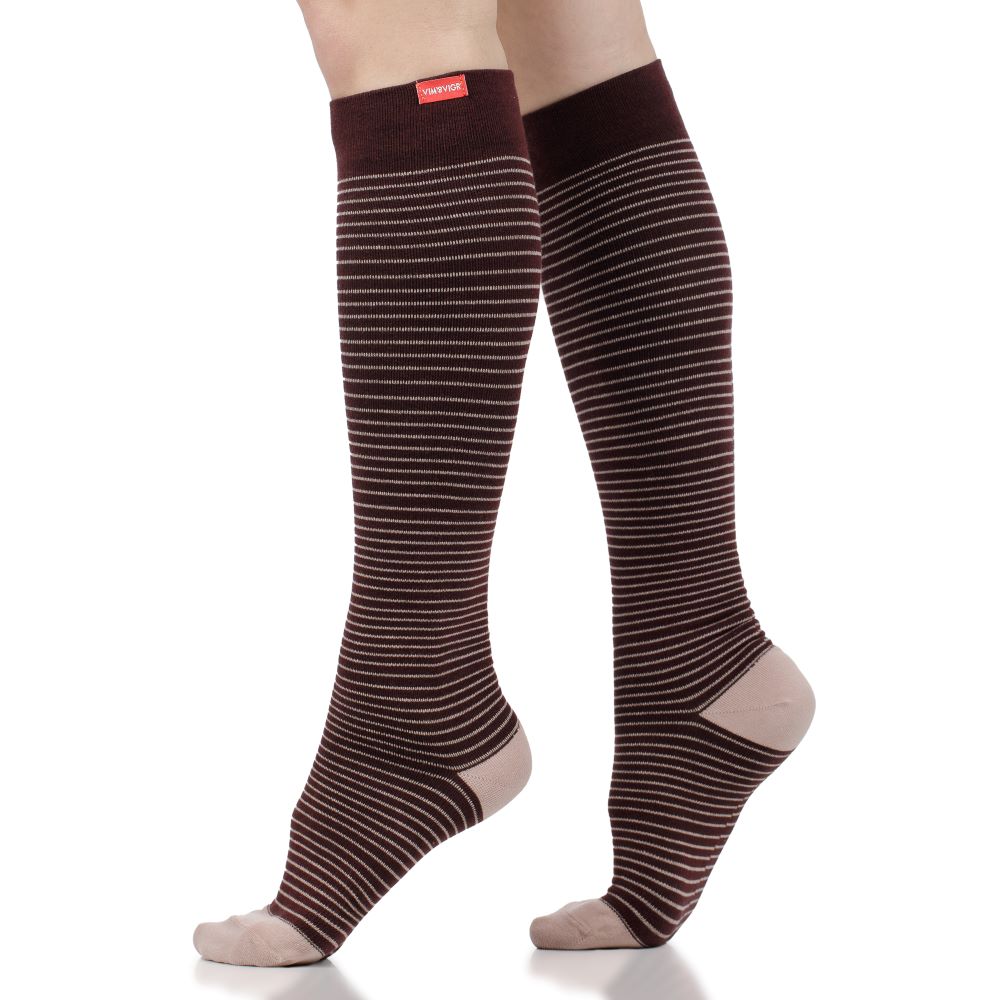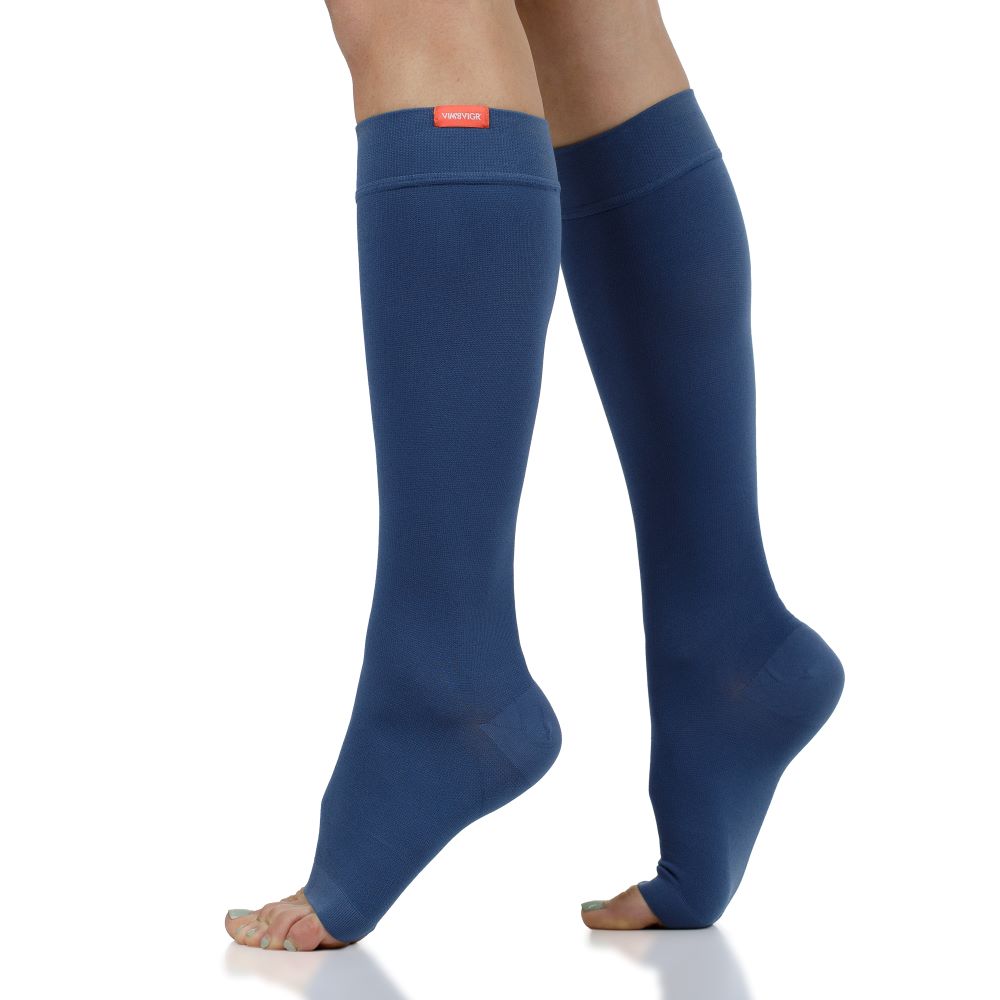Finding Comfort with Compression Socks for Morton's Neuroma
Suffering from Morton’s neuroma can be debilitating. Morton’s neuroma is a condition caused by swelling along a nerve that leads to pain, numbness, tingling and other uncomfortable sensations in the foot. But the good news is that Morton’s neuroma can be managed, and you can find relief either through your choice of shoe, compression therapy, or other actions.
Can compression socks help with Morton’s neuroma? Thanks to the way compression socks support healthy blood flow by massaging the feet and legs, compression socks can provide a lot of comfort and limit pain relief.
In this article, we will cover all you need to know about wearing compression socks when suffering with Morton’s neuroma, including how to wear them, and how to choose the best pair for your case.
Pain from Morton’s neuroma is caused by pressure on a nerve in the forefoot, leading to pain and serious discomfort. Reducing the pressure on the feet will also help manage the symptoms of this condition, lowering the risk of further pain and inflammation. So, you may be asking yourself, “Should I wear compression socks if I have Morton’s Neuroma?”
Compression socks could decrease the pain associated with Morton’s neuroma by reducing the pressure on the feet through ensuring constant blood flow in the extremities and supporting the feet and leg muscles. One study suggests that modifying your footwear, like wearing compression socks, is the first stage in treating Morton’s neuroma.
Wearing compression socks can help boost circulation, which reduces the risk of swollen feet and ankles. Improved blood flow is also critical for recovery from surgery for Morton’s neuroma. So, if you have had surgery to heal Morton’s neuroma, you may want to consider wearing compression socks to improve blood flow and reduce pain. Finally, compression socks maintain foot stability, giving you a sense of added balance and comfort in softer shoes (which are recommended for those suffering from this condition).
Understanding Morton’s Neuroma
According to Harvard Medical School, Morton’s neuroma is a condition caused by compression of the nerve in the forefoot that carries sensory information from the toes upwards. It is currently unclear what causes swelling and compression in this area, but we know that the swelling and compression leads to the bones and ligaments putting additional pressure on the nerve in the foot. This then causes more inflammation and pain as well as numbness or tingling in the foot.
Most often, Morton’s neuroma develops between the third and fourth toes, but it can also appear in other locations. It is a condition more prevalent in women than in men, which could be the result of footwear. Research suggests that Morton’s neuroma is more common in women because women’s shoes are often tighter fitting. The narrow-toed design favors the toes staying in a shape that can cause pressure on the nerves in the foot. High-heeled shoes cause hyperextension of the toes, which could be a major cause of Morton’s neuroma in women. Being overweight has also been identified as a risk factor for Morton’s neuroma.
How Compression Socks Work for Morton’s Neuroma
There are many non-invasive ways to reduce the pain from Morton’s neuroma, starting with a change in footwear and using padding underneath the toes and ball of the foot. Compression therapy may also be greatly beneficial because it stimulates blood flow into the feet and lower legs, which supports recovery from stress and reduces inflammation.
The therapeutic pressure that compression socks apply to the lower limbs helps increase peripheral circulation. This reduces the risk of swelling caused by fluid build-up. Blood is effectively pushed upwards from the lower legs towards the heart, which is extremely helpful for people who spend a lot of time on their feet. Some of our customers tell us they feel more energized and lighter. Additionally, compression socks have been linked with reducing the risk of circulatory problems such as varicose veins and deep vein thrombosis.
In the case of Morton’s neuroma, an increase in blood flow helps bring down swelling and inflammation in the feet. Additionally, compression socks may offer better support for the ligaments and joints. This potentially reduces the pressure on small bones (like the 3rd and 4th metatarsal heads) and nerves (like the plantar digital nerves) in the feet throughout the day. This is why they’re often used by athletes recovering from foot injuries such as plantar fasciitis.
Potential Benefits of Compression Socks for Morton’s Neuroma
Research has found that compression socks can reduce swelling and discomfort in the lower legs. This reduces the burden of additional pressure and inflammation on the nerves of the feet, which could reduce the symptoms of Morton’s neuroma. They also provide additional support and stability, while boosting peripheral circulation.
Pain Relief
The main source of pain for patients with Morton’s neuroma comes from the pressure that swelling exerts on the interdigital nerve. As a result, any action that can decrease pressure and swelling in the lower extremities could also help relieve pain from Morton’s neuroma.
For difficult cases of Morton’s neuroma, surgery might be necessary. During the recovery period, patients will benefit from using compression socks to boost peripheral circulation, especially while resting. This will reduce the risk of swelling and may help speed up recovery. Moreover, compression socks offer much-needed support and stability when patients return to walking or other activities after surgery.
Reduced Swelling
By increasing the flow of blood to and from the feet and lower legs, compression socks help reduce swelling and inflammation. They also lower the risk of fluid buildup. Fluid accumulation and retention in the legs can make the feet swell and put pressure on the nerves, worsening cases of Morton’s neuroma.
Improved Circulation
The main benefit of wearing compression garments is the boost to circulation and maintain a healthy cardiovascular system. Graduated compression socks are tighter towards the feet and slowly release pressure as they climb up the leg, which stimulates blood flow upwards from the legs and feet. This helps support vein health and healthy blood flow through the legs and the whole body, which could reduce the risk of circulatory problems as well as pain and pressure in the extremities.
Finally, better blood flow also helps with recovery from injury. This may be why doctors prescribe compression socks after surgery for Morton’s neuroma.
Support and Stability
When changing your shoes to accommodate for problems you face with Morton’s neuroma, you may feel less stable or supported than before. This may be especially true for switching out of high heels to softer footwear. Compression socks do not have in-built support, but the tight grip they have on feet and ankles gives a welcome feeling of added stability that feels particularly comfortable when wearing soft shoes.
Additionally, compression socks provide added support for the muscles while walking, running, or hiking, reducing soreness and the likelihood of pain, inflammation, and other discomfort.
Interested in trying compression socks? Browse our collection here!
When and How to Wear Compression Socks for Morton’s Neuroma
You can wear compression socks for Morton’s neuroma as long as you feel comfortable, but we recommend starting with 2-3 hours at a time if you’ve never worn them before. Then, as you become familiar with compression wear, you can keep them on for the entire day.
Compression wear is not only effective at reducing swelling and inflammation but also at preventing it. So, wear your socks during long days on your feet or when you know you will be sitting for extended periods of time without moving (e.g., on a flight or on a road trip). This will help prevent swelling and discomfort in the first place.
When recovering from Morton’s neuroma surgery or to better support your feet when you suffer from this condition, you should also put on your socks for walks and/or runs. Some of our customers say the added stability will feel particularly reassuring.
Choosing the Best Compression Socks for Morton’s Neuroma Pain Relief
To ensure that your socks work their magic to relieve pain from Morton’s neuroma, always follow a sizing guide to buy a pair that’s tight enough, but still comfortable. Otherwise, you simply will not get the benefits of wearing them.
Additionally, compression socks come in varying degrees of pressure – from everyday wear a 15-20 mmHg, to tighter 20-30 mmHg, and finally medical-grade 30-40 mmHg. For beginners, the 15-20 mmHg will be enough to get you used to the feeling of compression while boosting circulation and adding some support to the feet. Discuss with your doctor if you feel that you need more pressure.
Another important factor when choosing your compression socks is the fabric:
- Cotton is extremely versatile and comfortable, ideal for everyday wear and available in lots of different colors and patterns;
- For sports activities and a slicker, tighter feel, our nylon and moisture-wick nylon ranges are a great choice; we also offer our choice nylon material, which is slightly softer and comes without a toe seam;
- Merino wool is ideal for all-weather temperature regulation, from cold and wet days to the summer; it’s also antibacterial and hypoallergenic.
Whichever compression level or material you choose, ensure that you always listen to your body and adjust the time you keep your socks on based on how you feel. If you have any doubts or need to know more about using compression socks to manage your Morton’s neuroma, always discuss with a medical professional.
References
Bennett, G. L., Graham, C. E., & Mauldin, D. M. (1995). Morton's interdigital neuroma: a comprehensive treatment protocol. Foot & ankle international, 16(12), 760–763. Read it here.
Munir, U., Tafti, D., & Morgan, S. (2023). Morton Neuroma. StatPearls: StatPearls Publishing. Read it here.
Dahm, K. T., Myrhaug, H. T., Strømme, H., Fure, B., & Brurberg, K. G. (2019). Effects of preventive use of compression stockings for elderly with chronic venous insufficiency and swollen legs: a systematic review and meta-analysis. BMC geriatrics, 19(1), 76. Read it here.






















Leave a comment